#gator guide
Explore tagged Tumblr posts
Text
Complete 2023 Furblet Teardown/Disassembly Guide
hi!! this post will be an image heavy teardown guide for the newest 2023 furby furblets. questions are welcome!
Be aware there will be skinning and disassembly below the cut!
You will need:
A PH1 size screwdriver
a stiff, strong, thin prying tool (like a very thin flat head screwdriver, a butterknife, a palette knife, etc.)
a second stiff tool to pull/push on tabs (i used a mini plastic curved scraper)
optional, but a small magnetic mat and a small container (or just 2 containers) to hold parts and screws so you don't lose them!
This is my volunteer model ooh-koo!
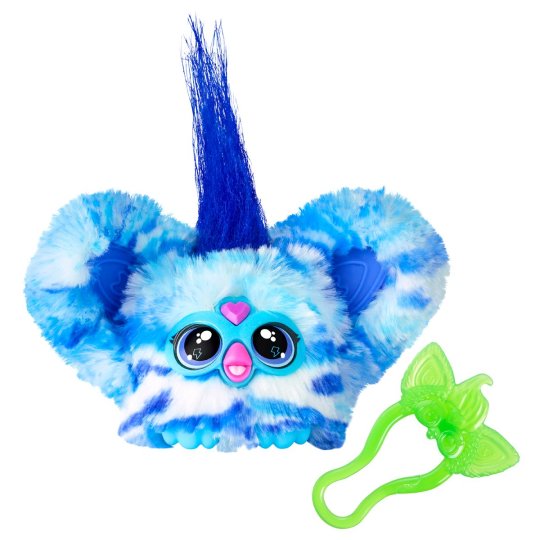
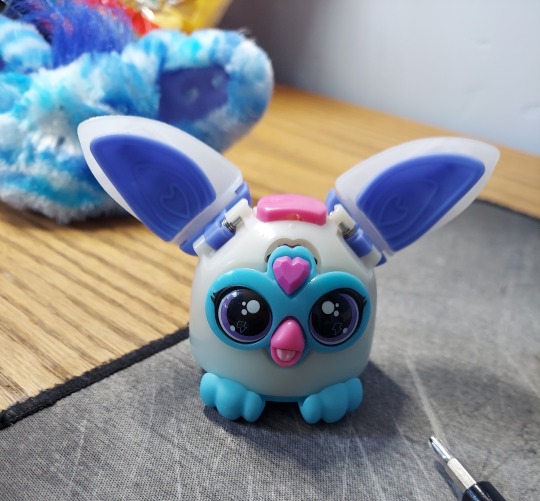
She is in complete working order, both before and after the teardown. There aren't many fragile parts inside furblets (they're surprisingly simple but clever!) but I still do not recommend following through with this disassembly unless you're absolutely fine with damaging your furblet. Furblets are NOT meant to be taken apart, and are filled with 1-way safety pins in the faceplate that cannot be removed without bending/breaking them out.
To start, remove all visible screws on the underside of the furblet where the battery compartment is. There are 6 total screws, two larger ones for the battery compartment and 4 smaller ones on the outside holding the bottom on to the furb. These screws are different sizes, don't lose them and put them back in the right places! The bottom of your furby should look like this now:

(i forgot to take a photo of this initially, so she is skinless here.)
After this, you should very easily be able to lift the plastic strip holding the fur into the shell. Part of it is tucked into a nook to allow slack in the fur for lifting it over the body!
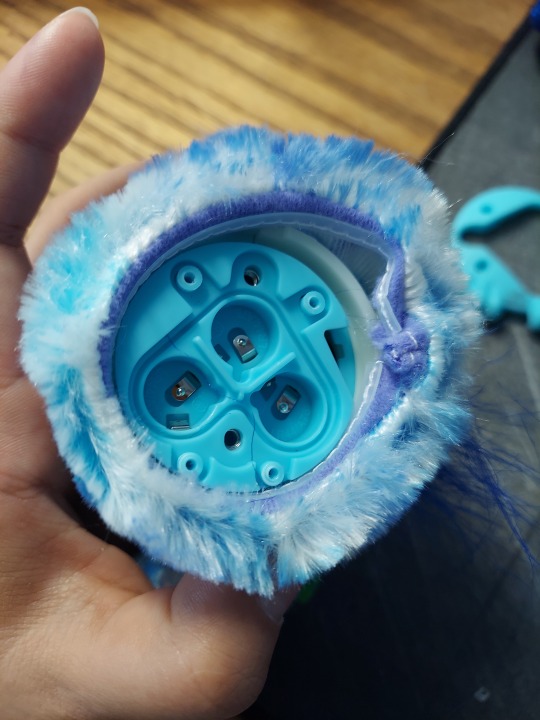
After this, gently pull the fur up and over the body shell, and flip it over the ears. These are held in place by plastic clips so be gentle and don't force it off yet.
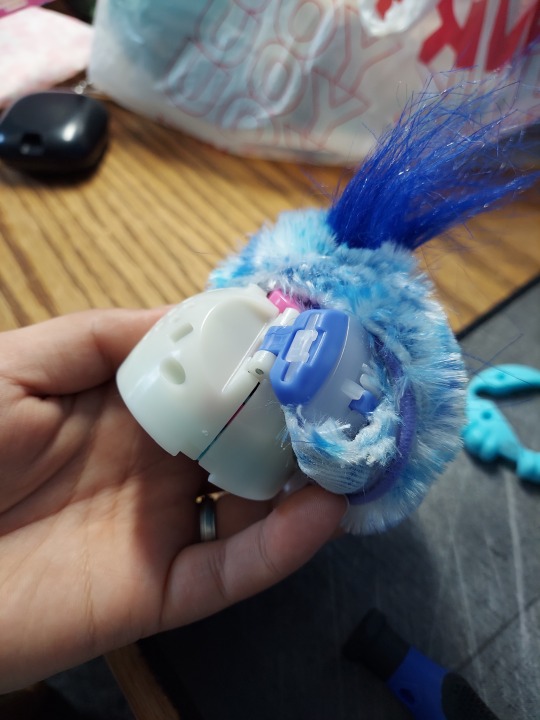
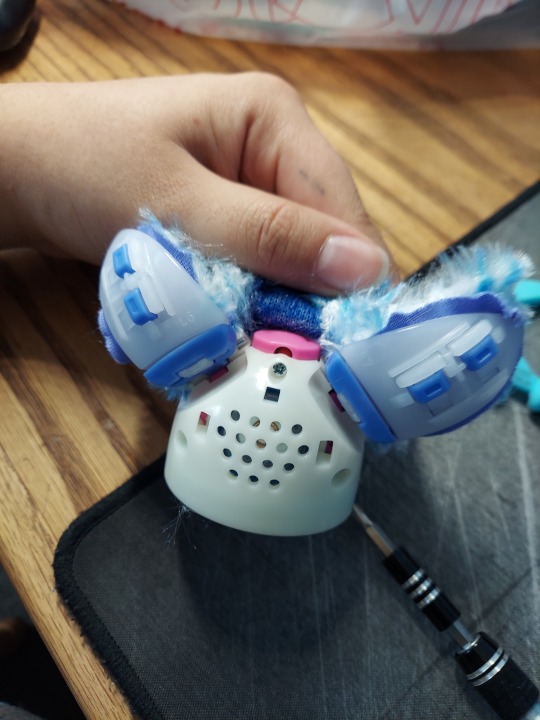
now for the most genuinely difficult part of the whole process, unclipping the ears
Holding the ear on the front and back to sandwich the pieces together, and being VERY gentle, slide your first prying object under the wide end of the white ear clips. This will lift it to allow you to pull the clips up over the barrier. While still leaving the pry in, use your second object and push/pull on the clip. Here I am pulling since my scraper is curved and it was easiest. The T shaped clip should pop right out, but may need a lot of finagling to get it there. I stretched the second clip and damaged it, so again be slow and careful!
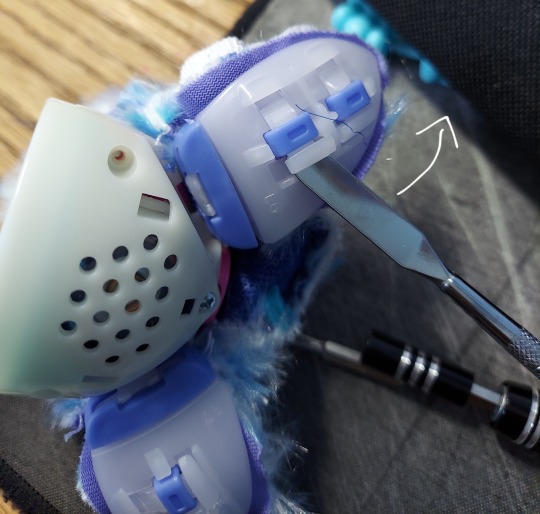
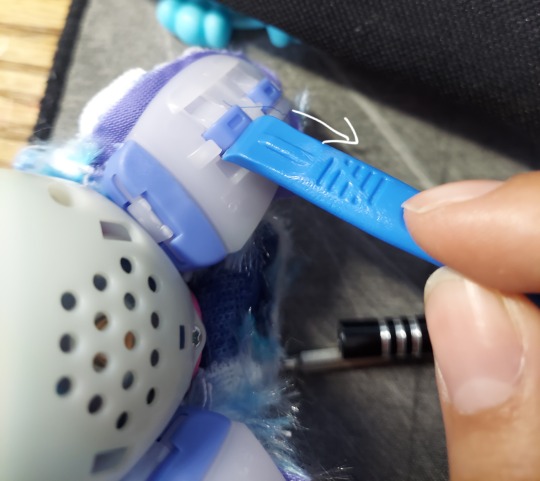
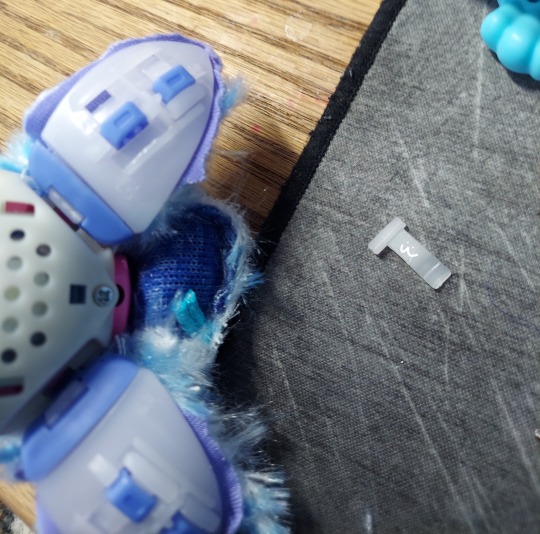
Repeat this process on all four tabs! Now, the skin should only be held on to the furb by the face plate.
To open up and remove the faceplate, start by removing all three screws on the back of the shell. Again, I forgot the picture initially so she is already skinless here.
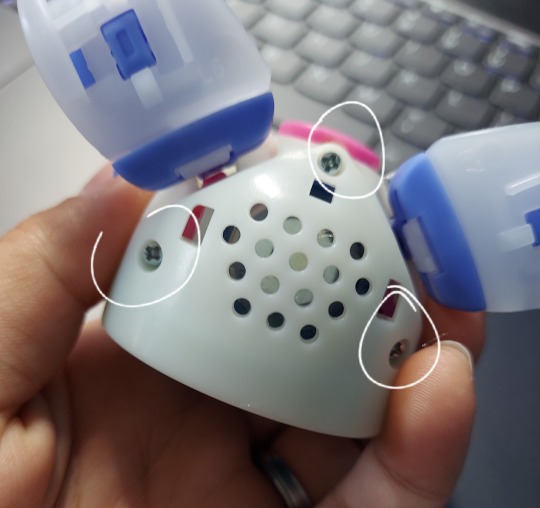
Now, pull apart the two halves of the shell. The microphone is wired from the center board to the back half of the shell, so don't pull too hard or you might rip the wires out!
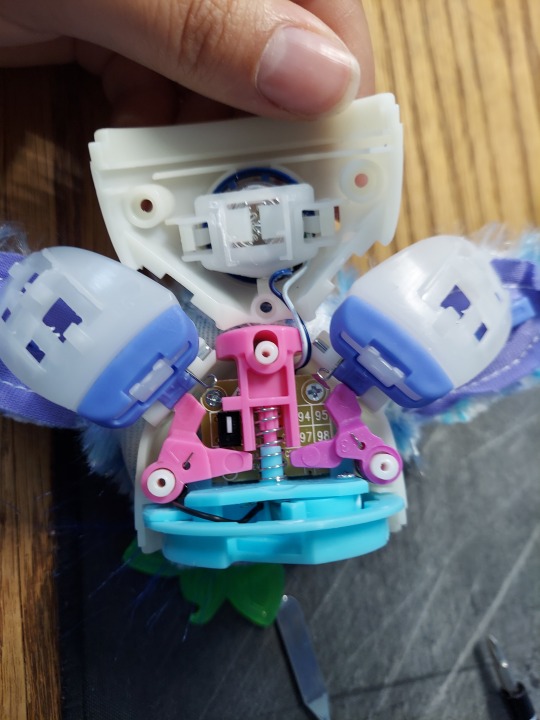
Pay attention to your individual furblet! Mine has pink and purple components, remember or take a picture of the lay out so you aren't confused later. the pink and purple parts on either side just pop right out, and the button slides off the peg along with its spring. This will give you full access to the backside of the motherboard.
Remove the screws on either side, and it will release the whole center plate from the front half of the shell. There is a third screw on the bottom of the center plate, but this only separates the battery contact plate and the base plate of the motherboard (i wouldn't really recommend removing it since it's not relevant to anything you need access to) The whole center plate will now just slide out of the empty front half of the shell!
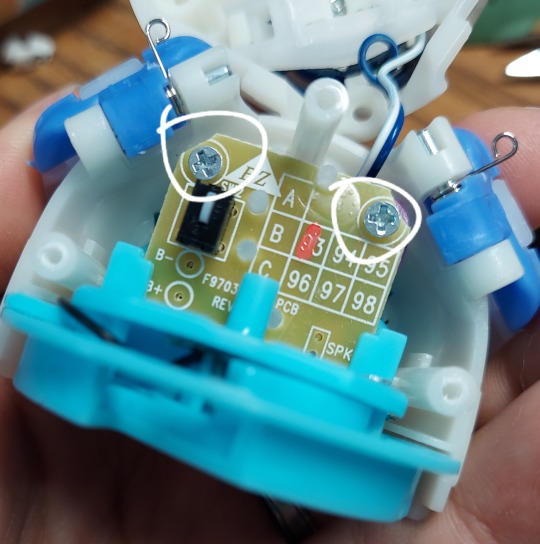
There is one additional piece kind of floating on the pegs here, and it's needed so the furb recognizes button presses to the mouth. Here it's the J shaped purple piece! This just pops right off and you can see all the safety pegs for the faceplate and mouth/gem buttons. To remove the pegs, you will have to manually bend the tabs holding the pegs in place. This WILL damage your furblet. Do not go further if you aren't wanting to break anything.
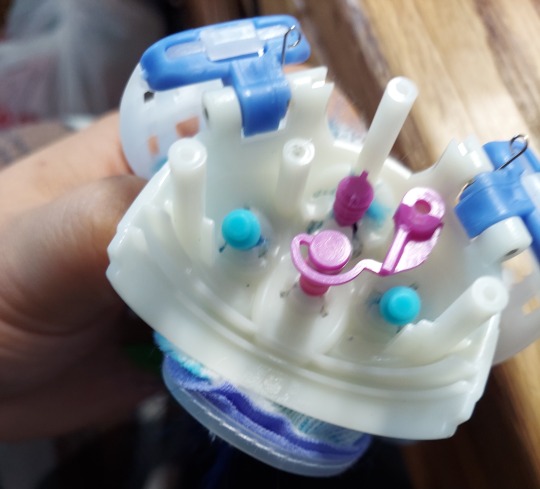
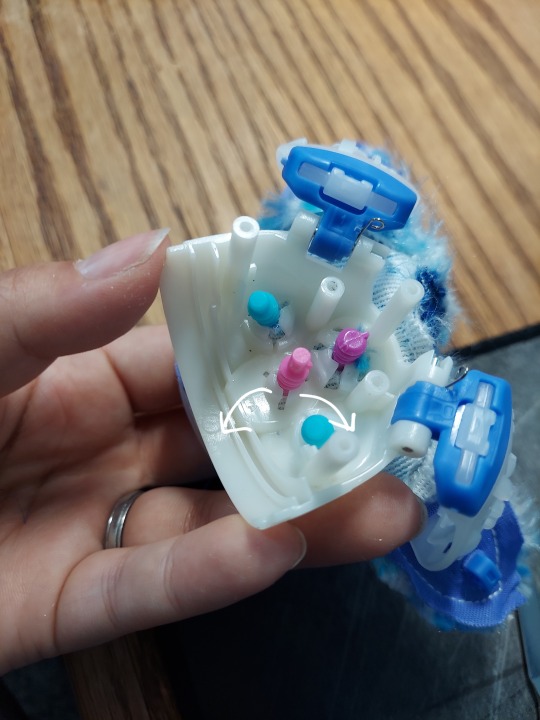
After bending the tabs out, the pegs should pull straight through, releasing the whole faceplate. At this point, the skin should come right off too! Here are the inside and outside parts.
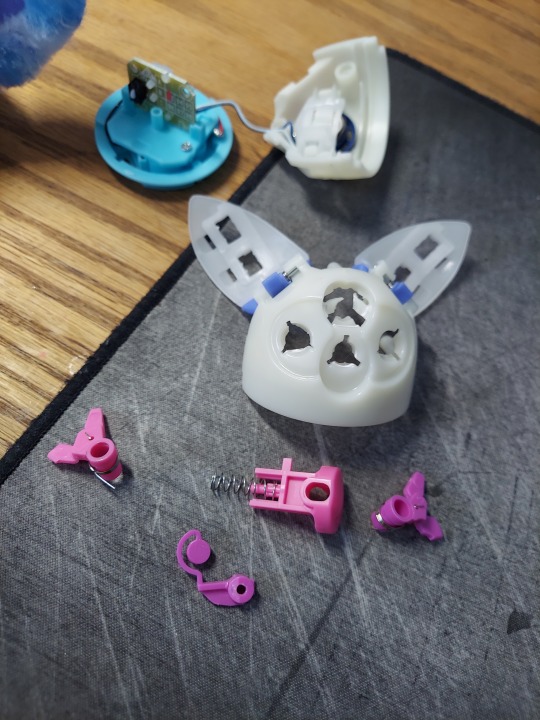

Congrats! You've completed a disassembly. To put your furblet back together, just do everything in reverse!, however please note the following:
When reassembling, be sure to replace all spring parts in their correct positions! The ear mechanisms are reliant on all of these springs to work. For the inside, make sure the Y shaped brackets are on their correct sides, and that the end of the metal spring is INSIDE the furb, pushing against the bottom plate (the left side here has a small divot where the left side spring goes, the right side just kind of sits on top of the plate)
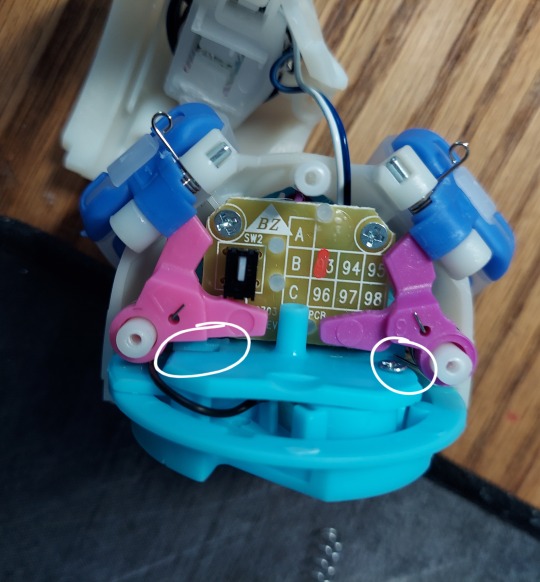
Similarly, when replacing the shell be sure to lift the ears all the way up and close the metal pins into the shell. This puts tension on the spring so they'll be able to pop out when the button on top is pressed. Test the button to make sure everything is working mechanically!
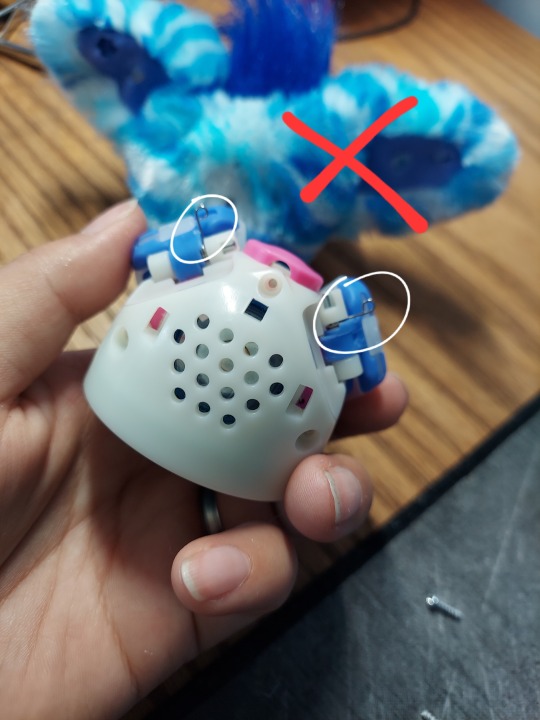
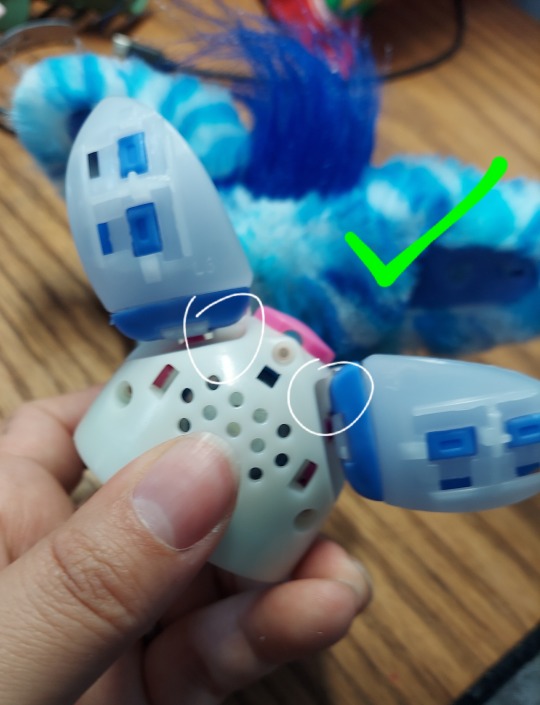
And that's all! This wasn't very difficult to do, but because of the actual inevitable damage caused by removing the face plate, i figured it wouldn't be a bad idea to make a guide of some sort. Please feel free to use and link this guide however you see fit, but please don't use my photos! Thanks for reading 🩵💙
#furby#furby community#furby guide#gator guide#furby disassembly#furby furblet#furby custom#all furby#furblets
100 notes
·
View notes
Text
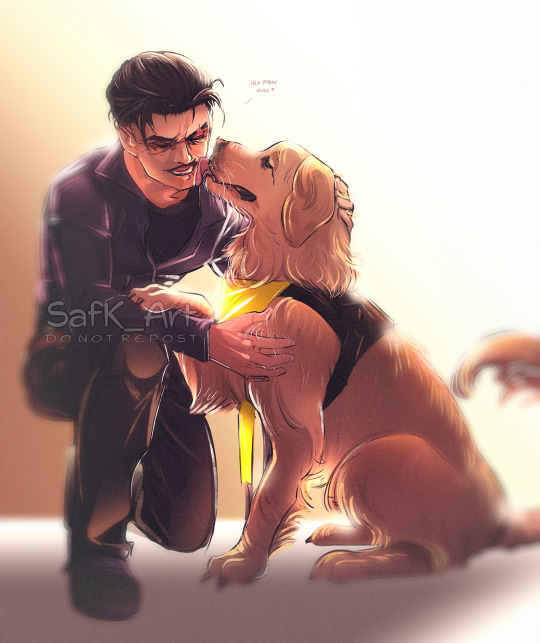
Dot :)
[Patreon] [instagram] [Twitter] [BluSky]
193 notes
·
View notes
Text
We deal with our newfound feelings for the mer boys and Moon seems to be having the time of his life teasing us for it.
We also get a visit from a couple of new mers… Why do they resemble a bear, chicken, wolf and gator??
Chapter 9 is out!!
Chapters: 9/?
Fandom: Five Nights at Freddy's
Rating: Teen And Up Audiences
Warnings: No Archive Warnings Apply
Relationships: Moon/Sun (Five Nights at Freddy's)/Reader, Daycare Attendant (Five Nights at Freddy's)/Reader
Characters: Sun (Five Nights at Freddy's), Moon (Five Nights at Freddy's), Reader, Vanessa A. | Ness, Gregory (Five Nights at Freddy’s), Glamrock Freddy, Roxanne Wolf, Glamrock Chica, Montgomery Gator
Additional Tags: MerMay, Merperson Sun (Five Nights at Freddy's), Merperson Moon (Five Nights at Freddy's), Sun and Moon are Separate Animatronics (Five Nights at Freddy's), Siblings Moon and Sun (Five Nights at Freddy's), Fluff, Non-Sexual Intimacy, No Smut, Gift Giving, Sleepy Cuddles, First Meetings, Slow Burn, for reader anyway, sun and moon fall for reader first, Courtship, Cultural Differences, Mutual Pining, Eventual Romance, Soft Sun (Five Nights at Freddy's), Soft Moon (Five Nights at Freddy's), No use of y/n, POV Second Person, gender neutral reader, Vanessa is your mother figure, Cuddling & Snuggling, Bioluminescence, Possessive Behavior, Jealousy, Tooth-Rotting Fluff, Hurt/Comfort, Miscommunication, but it’s just reader being oblivious, Feelings realization
Summary:
You find two merpeople stuck in a fisherman's net and decide to help free them.
You don't expect to see them again after that night, but it turns out that they have other plans. As you're suddenly being showered with gifts and shiny trinkets from the depths of the ocean, you start to wonder what you've gotten yourself into.
After all, you didn't expect the two mers to suddenly start courting you.
or basically, Mer! Sun & Moon try to romance the reader, but reader is as dense as a rock.
#a step by step guide on mermaid courtship#fnaf security breach#five nights at freddy's#sundrop#moondrop#fnaf dca#fnaf dca x reader#fnaf daycare attendant#fnaf fanfic#mer sun#mer moon#glamrock freddy#glamrock chica#roxanne wolf#montgomery gator
24 notes
·
View notes
Text
the 5 best games i played in 2024
this is not a "top games of 2024" list, because, as always, i failed to play more than a handful of games that were released this year. instead, these are my favorites of the... 14 or so? games i beat for the first time this year. enjoy!
i tried to limit myself to putting one game per franchise on here. sorry, dark souls 3.
1. Dark Souls (2011)

a game about being one little undead warrior in a big mean world <3
dark souls! what a game! though i technically started playing this in december 2023, i think i'm allowed to count it among my 2024 games.
moreover, this is definitely going on the "favorite games of all time" list. i adore dark souls. it's rare that i start playing a game and instantly feel like we're speaking the same language. i love the weirdness and awkwardness of it, i love the grungy medieval fantasy atmosphere, the great characters, the difficult but satisfying combat, the incredibly memorable environments... the list goes on. there's a reason this is a classic. it's a very silly game and also a very clever game. i am incredibly glad that i decided to give it a try.
2. Silent Hill 2 (2001)

a game about a man who travels to a strange, empty town in search of his dead wife.
there was this one night in october in which i played through a frankly ridiculous chunk of this game in one sitting, and afterwards i felt completely insane in a way that i have very rarely experienced!!! what did they put in silent hill 2 to make it one of the most emotionally arresting game stories i've ever seen? i'm still trying to answer this one. add to that some top-notch atmosphere, excellent scares, and an environmental design philosophy that makes the world seem simultaneously more real and more surreal... and you get an incredibly tight, smart game where every part of it contributes to crafting the experience.
3. Inscryption (2021)

a game about playing a life-or-death game of cards in a spooky cabin with an old man who likes to cheat.
speaking of very clever video game stories!! inscryption is a fantastic addition to the metafictional games canon. of all of the games here, i think this one surprised me the most - it plays with your expectations so deftly, and all in service of a deliciously simple meta premise. helps that the core gameplay is extremely addictive, too. this was my balatro
4. The Beginner's Guide (2015)

a game about a guy showing you a few short games his friend made.
can i put a game on this list that i haven't played myself? though i watched courtesy play it, it's more or less a "walking simulator" sort of a game, so i got more or less the same experience. anyway, this is another metafictional game that subverts expectations in a major way that i am still thinking about nearly a year later. unfortunately, this is another one i shouldn't talk too much about - it's short, you should just play it yourself.
5. Lil Gator Game (2022)

a game about a lil gator trying to build the best playground game ever with their friends!
not only is this a very cute game about a cute gator exploring a big island, it is also a beautifully written game about games. not in the same way as inscryption or beginner's guide - it's about playground games! as someone who played a lot of those as a kid, this one struck a chord with me. it's also very creative, consistently laugh-out-loud funny, and all around charming.
honorable mentions:
Sable (2021) - what a cool world. what a cool way (and cool reason) to explore a world. this one majorly scratched my "exploring and collecting things" itch.
Dark Souls 3 (2016) - dark souls 3 is just really good, guys.
and if you want to see a list of all the games i played/experienced this year, here it is!
#yay!#technically the year is not over yet#and i'm still in the middle of two games#but i think it was time to finally write this list#i've been thinking about it a lot!#my post#game reviews#dark souls#silent hill#inscryption#the beginner's guide#lil gator game
8 notes
·
View notes
Text
Title: Buggy's guide to bagging boyfriends
Chapter: 4/?
Rating: PG
Word Count: 2035
Chapter excerpt:
Buggy continues speaking after taking another moment to think of a reply, “It’s like this: I want to get on Crocodile’s good side and I believe that you and Galdino are the best people to help me do that.” He states plain and simple, “I really want to befriend your boss for the sake of Cross Guild, can you help me?”
Daz gives him a rather puzzled look for a moment before his face quickly returns to its normal neutral state. “He likes Bananawanis.” What in god’s name is a Bananawani? Is that a cake or something…? He asks Daz what exactly a Bananawani is and when he elaborates…Buggy’s even more confused.
|Ch1|Ch2|Ch3|

As soon as he can, Buggy gathers up a rather reluctant Daz and Galdino, as well as a few other men, and sets sail, heading towards the nearest town in search of gifts for Buggy’s future best friends. It’ll take them two days, maybe two and a half days to get to their destination, but that’s okay because it gives Buggy plenty of time to plan! Now that he’s alone with two people who probably know Crocodile the best, he wants to question them to get a feel of what kind of gift their beloved boss might possibly want, and maybe, just maybe, if he’s lucky, they’ll also know a thing or two about Mihawk.
He starts with Daz first, and truth be told…Daz is kinda cool and intimidating in his own right, and Buggy wonders if maybe he could be friends with Daz too, but then again, Daz doesn’t seem to like anyone other than Crocodile. Whatever, he can worry about befriending Daz later. He loses track of him after they leave the docks, but quickly finds him in one of the ship’s cabins, keeping to himself like he usually does. Buggy knocks on the door first and once he receives permission to come into the room, he quietly enters, grinning sheepishly, “Hey, there…!” He says, greeting Daz.
Daz nods his head, “Chairman Buggy.” He greets back, getting up and standing in front of Buggy, showing a certain level of respect that Buggy didn’t think that he would receive from one of Crocodile’s men… Then again, this is one of the few interactions that Buggy has had with someone who is more or less considered Crocodile’s right-hand man, so he didn't know what to expect before coming into his room.
Keep it cool, Buggy, you wouldn’t want him to think you’re a dork or anything.
“Daz, I’m not sure if you know why I asked to have you come along on this journey with me or not…” Buggy states, slowly trying to pick out the right words to say in order to make himself look cool and not a loser desperate for friends because if there’s one thing Buggy’s not, it’s a loser desperate for friends… He’s just saying … Wouldn’t it be cool if he had two super c–
Now’s not the time for that.
Daz looks rather uninterested in the conversation. He stares at Buggy blankly, but remains respectful, giving him his full attention… Perhaps this fellow’s face just naturally looks bored though. “I don’t. Boss said that he wanted me to accompany you on this trip, and that’s all I needed to know.” Ah, so loyal! Almost as loyal as Buggy’s own children!
Buggy continues speaking after taking another moment to think of a reply, “It’s like this: I want to get on Crocodile’s good side and I believe that you and Galdino are the best people to help me do that.” He states plain and simple, “I really want to befriend your boss for the sake of Cross Guild, can you help me?”
Daz gives him a rather puzzled look for a moment before his face quickly returns to its normal neutral state. “He likes Bananawanis.” What in god’s name is a Bananawani? Is that a cake or something…? He asks Daz what exactly a Bananawani is and when he elaborates…Buggy’s even more confused.
It’s….It’s a giant crocodile…?
Buggy doesn’t know where one would get a giant crocodile, he doesn’t think he’s ever seen a pet store with one of those for sale… They are pets…right? Or are they for eating…? Buggy is utterly confused at the moment, and he asks Daz for further explanation, to which he replies, “They’re pets.” Ah…
“Does he like anything else?” Buggy asks, “Nothing like money though because that’s too easy. I really want to impress him and make it seem like I got him a gift that came right from here.” He says, pointing to his heart.
“No, just Bananawanis, they make very good guard dogs, and the boss likes to feed them and cuddle with them.” But… They’re crocodiles?!
Buggy stares at Daz for a long moment, unsure of how to reply, and Daz…Daz stares back at Buggy, showing that he’s dead serious about this whole Bananawani thing, not that Buggy thought he was joking around to begin with because he’s not exactly the type of person who tells jokes. “Ah, yes…Bananawanis…” Buggy nods, but he doesn’t know what else to say, “And…out of curiosity… where does one acquire such an animal?” he asks after giving the question some thought.
“The black market.”
Buggy should have expected an answer like that because it makes sense when you stop to think about it. A Bananawani doesn’t sound like something you would find on a farm or in a pet store… Buggy has bought a lot of things off the black market, but he’s not quite sure how he feels about buying a giant crocodile off it, or the idea of having one possibly roaming around Emptee Bluffs Island in general. “Boss said he wanted to get a few anyways, so maybe you could get him the first one.” A…A few? As in plural? As in, he wants to have more than one giant crocodile roaming around the island… That sounds… Horrific.
Okay, Bananawanis for Crocodile…But what about Mihawk?
Buggy proceeds to change the subject after that, asking if Daz has any clue what sort of gift Buggy should get for Hawkeye. Daz simply shakes his head in response, “I don’t know Hawkeye very well.” He states, quickly bringing that little conversation to an end.
“Bananawanis…” Buggy mutters in a daze, “Ok, got it…Thanks, Daz.” He says as he heads out of the cabin. He’s a lot more confused now that he’s left than when he originally went in. He doesn’t think that he’s going to get Crocodile…well, a giant crocodile as a pet though because the whole idea sounds strange and terrifying at the same time.
But, what is he going to get him?
Buggy’s going to consider his little talk with Daz a failure, or maybe it wasn’t, maybe he got good advice, but he just can’t use it. He looks around for Galdino next, who is relaxing in the kitchen of the ship, reading a magazine when Buggy enters. Now, Buggy’s always considered Galdino a friend, they’ve been through so much together, but as soon as Cross Guild was formed, Galdino made it known that those feelings weren’t mutual and that he only cared about his beloved boss, Crocodile, which is a shame because Buggy really thought they had a close bond with each other, especially after the war, but maybe he was wrong.
As soon as Galdino spots Buggy, he rolls his eyes in annoyance, and unlike Daz, Galdino doesn’t treat Buggy with even a little bit of respect. “I still don’t get why you insisted that I come on this dumb trip with you,” He says, sighing in frustration, “In fact, if it were up to me, I wouldn’t have even stepped foot on this ship, but the boss asked me for a favor, so what else could I do?” Poor, loyal Galdino, he must be miserable right now with the cruel and cold-hearted Buggy, it’s not like Buggy’s ever treated him like a friend or a member of the family, oh, no. This must be awful for him, look at him suffer while he sits around, lounging.
Buggy has a seat at the kitchen table with him, and sighs as well, “Look, I wanted you to come on this trip with me because I want to get closer to Crocodile, and I need your help doing that.”
“And why would I help you?”
“I’ll say you helped me pick his gift out, and you’ll be on good terms with Crocodile too.”
“Deal.”
Damn, it didn’t take much to convince him, did it? Buggy thinks as he watches Galdino drum his fingers against the kitchen table, seemingly lost in thought. A moment later he gasps softly, “You could get him a new suit, and, oh, wouldn’t it be lovely if you could get your hands on the imported cigars he smokes?!” Okay, now this sounds like a better lead than the whole Bananawani thing, but honestly, it feels kind of boring and predictable, doesn’t it? He’s sure that Crocodile has plenty of suits, and as for cigars, he doesn’t seem to have a shortage of them either. In fact, Buggy’s pretty sure that Crocodile just had some shipped to the island not too long ago. “ I even know his measurements!” Galdino proudly proclaims, “So, if you want to buy him a suit, we can do just that!” Why does he have that information at his disposal? Has he bought Crocodile a suit before or…?
Buggy gives the idea some consideration, but it doesn’t seem good enough. He doesn’t think those things will get him on Crocodile’s good side, but he’s still not sure what will right now. He’ll just have to think of something else later. “Okay, any suggestions for a gift for Mihawk?” Buggy asks a moment later, Daz might not know anything about Mihawk, but maybe Galdino does.
Galdino takes another long moment to think about Buggy’s question. He gasps and then looks like he’s about to say something, but then shakes his head before going back to thinking about the question again. Jeez, Hawkeye really is a hard guy to buy for, isn’t he? “Oh!” Galdino exclaims excitedly, “Oh, I know. Hawkeye likes to garden.” He does? “So I suggest getting him a beautiful plant, one that’s just as bold and striking as Sir Hawkeye is!” Sir Hawkeye…???
Buggy narrows his eyes at Galdino, unsure if what Galdino is telling him is the truth or if it’s gossip or a joke. He isn’t buying into the idea that the world’s strongest swordsman is into plants, he’s way too cool for something like flowers and stuff. “How do you know he likes to garden?” Buggy asks, suspicious now.
“You haven’t seen his garden on the island?” Galdino asks with a scoff, “Everyone knows about it.” Uh, no… Buggy hasn’t seen Mihawk’s garden, he doesn’t even know where you would put one on Emptee Bluffs Island or if it’s even the right place to grow things…Regardless though, Buggy puts on an act, scoffing right back at Galdino, “Of course, I know about his garden, who do you think helped him plant all his flowers?”
“He grows vegetables.”
“Same shit. Anyways, my point is, how do you know he would even want another plant to take care of?”
Galdino once again scoffs at Buggy, like Buggy is a fool who knows absolutely nothing! Which is true, but how dare he call Buggy out on his ignorance! He’s the chairman of Cross Guild, and if… if Buggy wanted to, he could have Galdino punished for his disrespect…he won’t, for reasons, but just know he could. “Obviously Sir Hawkeye gardens as a means to relax, and I often see him roaming around the island, looking at all the plants with great interest. So, I think he would love a new plant.”
All Buggy’s getting from this is Galdino is nosey as shit.
Buggy really doesn’t want to get Mihawk a plant. That sounds so lame, who gives people plants as gifts?! Buggy is the future king of the pirates and if word got out that he was so boring and cheap, he’d never live it down. “Are there any other suggestions you might have?” Buggy asks with a small groan, he really doesn’t want to have to get Mihawk a damn plant.
Galdino frowns, seemingly displeased that Buggy didn’t take his earlier suggestion seriously. “I mean, you could always give him another sword.” Giving the world’s strongest swordsmen a sword? That’s probably the first thing everyone thinks of when it comes to giving Mihawk gifts. Soooo lame. Buggy doesn’t want to be like other people, he wants to be different. “Anything else??” he asks, hoping that a plant and a sword aren’t the best options Buggy’s got.
“Perhaps a book? He does seem like a bit of a bookworm.”
Ugh. Borinngggggg.
#one piece#cross guild#buggy's guide to bagging boyfriends#my writing#i usually use the english translation for things but i refuse to call bananawanis banana gators#ajsdlasjdalsdj dont ask why i draw the line THERE
47 notes
·
View notes
Text
#j.txt#cnp ocs#I keep going back and forth im too indecisive for this. so i come to you my friends and followers to guide me true#I feel a deep inclination to make jackal butch but perhaps that is just bc I love gruff but secretly softie women characters....#which jackal is keeping that personality no matter what idc. my prickly little artiste<3#for gator I orig thought i would make them transfem and I still like idea but idk abt if thatd be too stereotypical for her to work-#in a brothel... even though all she does is sing and play music there#I mean I can always make it work I yam just overthinking probably. so I shall defer to popular sentiment here !#oh for the yuri/yaoi options. one or both will likely remain trans in either scenario bc I Do What I Want. just so that is clear<3#ghost city ocs
8 notes
·
View notes
Text
caligator: guide dog Billy's collar

That is all.
22 notes
·
View notes
Text
Dawning on me as I write for Nathan for the first time but the most unrealistic thing about his character to me is that he, as a floridian, never says "Y'all".
I say this, as a Floridian. It's not like we have much of a country accent or anything but yall specifically is so ingrained in me and many of my fellow florida born pals that I'm kinda surprised.
#metalocalypse#nathan explosion#i know a lot of people who dont#but theyre all from out of state#crack fic where Nathan is a local florida man just spawned#something insane like having a pet gator he “frees” from gator land#anything under 70 degrees is freezing to him#the first time he sees snow he fucking despises it#omg his whole spirit guide thing is with the ocean#floridians fucking love the ocean#its all clicking for me
12 notes
·
View notes
Text
oh, also, our boat broke down in the middle of a swamp today and we were stuck there for a few hours
#personal#travelblogging#that’s another reason i want some time to digest between events because this was actually a really interesting experience that i wanted to#write about to remember it y’know?#but instead we immediately went to more bars and i freaked the hell out!#i actually liked being stranded in the middle of the swamp. it was fun seeing everything going by; gators and great blue herons etc#that was a nice pleasant time that genuinely has expanded my world.#at first our tour guide was very nice and knowledgeable about all the wildlife pointing things out; apparently they name the gators#and the basic touristy ‘perfect’ view of the swamp is fun and all#but here in real life things go wrong. how do different people deal with these stresses? and it was fun talking to people from all over#while waiting for the help boat to arrive. again i really liked all that!#in comparison:#we went on a streetcar and my mom was upset that the lady wanted things to go efficiently. said ‘that ruined the whole experience for her’#but like. it’s public transportation. she’s just living her life; doing her job. why are you idolizing this?
3 notes
·
View notes
Text
i like it when theres a nonmagical wolverine in fantasy settings.
as in - it is a wolverine. it presents all of the problems present with every other wolverine, and would be a normal wolverine, except, by all accounts, you cannot deal with this wolverine by magic. magic doesnt work on this wolverine. spells dont work on it, it can chew on the intangible, nothing extraordinary you can do will affect this wolverine.
by all accounts, you could just take care of it like a normal wolverine. except, the issue, is that this is a world with magic, and magic problems, and magic is normal, so they want to solve the wolverine issue with magic. they want to do it so badly. but they cant. by all accounts, trying to do so makes the problem even worse. and, again, the danger is always that of a wolverine, the damage it can do limited to what any other wolverine can do. except no fancy amount of power-creep can ever make it stop it from being a wolverine.
#all the care guide says is 'biomass'#its so fucking funny to me and i love it#yes this is what im doing with merfolk#who would win: literal deities or a Weird Gator#WHICH AGAIN#THIS PROBLEM CAN BE EASILY SOLVED. IF YOU TREAT THE WEIRD GATOR. AS A WEIRD GATOR.#AND RESPOND BASED ON THAT.#BUT YOU CANNOT MAGIC AWAY THE GATOR#THE GATOR REFUSES
3 notes
·
View notes
Text
everyone with an instagram i must bring your attention to uf.metaknight because i’ve been losing my mind over this account since last august
#rhyn rambles#it’s so funny it’s so dramatic it’s so dumb it’s so heartbreaking#uf meta knight is improving my college experience!!! GO GATORS!!!!#the story will be ending soon because the admin is graduating#but there’s a guide that’s been made so you can follow from the beginning!!#my favorite post is let go of me blade let go of me blade let go of me blade le
3 notes
·
View notes
Text
Fairy godmother cranes guide their confused gator godchild back into pond
27K notes
·
View notes
Text
you're literally about to faint.

jake 'hangman' seresin x f!reader
summary: jakey ghosts reader after he graduated topgun and now that he's back, he needs to get her back.
t/w: cursing, mentions of blood [nothing too graphic], angst, rooster taking care of reader. jakey is afraid of blood. not proofread. ill do that later gators.
your arm wipes down the bar top with a mind of its own as you watch the naval aviators fill the hard deck.
so far, all the aviators are top gun graduates you’ve met at one time or another. natasha, bob, coyote. rooster stops by the bar for a hug. you let him go and admire the view as he joins natasha and bob at the pool table.
only one person is missing.
hangman.
jake.
taking stock of who’s here, hangman should be sauntering in any minute. they’ve called the best of the best back for…well whatever it is they’ve here for.
“well hell, i must’ve died and gone to heaven.” a southern-drawl fills the space behind you. holding strong, you don’t turn to him, making him step in front of the bar.
he decided not to wear his service khakis, instead donning a flannel and fuckin’ stetson cowboy hat.
ugh. he’s playing dirty.
his green eyes hold yours as he tips his hat to you.
that fucker.
jake slides into the stool across from you. “how’ve you been, love?”
rooster’s gaze tears a hole in the side of your face. you can hear him now. don’t get involved with hangman…again. he’s bad news.
too bad jake has proved just how bad he is.
jake swept you up in a passionate relationship while he was attending top gun. once he graduated, your plan was to stay in miramar, and he had no control over his deployment.
he left without a word. never called. never wrote. never visited on leave. you couldn’t believe it. rooster couldn’t even get the words “i told you so” out once he saw how truly heartbroken you were.
“how’ve i been? jake, it’s been three years.” tears prickle the back of your eyes and you pray they remain at bay. you’ve cried enough of this blonde man.
your grandmother always warned you against blonde men. now you know why.
a smirk sits on his beautiful face, and for a second, you think you spot his confidence falter. as quick as it happened, he steels his gaze. being, or looking weak, wasn’t something jake allowed to happen.
"oh come on, angel. it hasn't been that long," he says. his eyes move slowly across your face, like he's memorizing your features. or checking his memory to make sure he remembered you exactly.
you make yourself busy by drying glasses and putting them in their pyramid home. if you look at jake too long, he'll pull you right back in.
"you really lived up to your callsign, didn't you," you say to the glass and not him. "you sure did hang me out to dry."
this strikes a nerve, the words cut through him like butter. "y/n, that's hardly fair."
the glass in your hand slams to the counter, shattering in your hand. "fair? you know what's not fair? waiting for you. for anything from you." his eyes lock with yours and your chest heaves under the weight of finally getting these feelings out in the open.
"it's not fair what you did to me," the words are low, almost inaudible.
jake's gaze flits down to your mouth...no...your hand?
he opens his mouth to say something, but no words come. he tries again, swollowing hard. he points.
looking down, you understand what he was trying to tell you, and now that the adrenaline has run it's course, pain shoots through your hand.
the two of you balk at each other, both paling. "baby, your hand," he breathes.
rooster immediately jumps into action. "hangman, you're in the motherfucking navy!" rooster rounds the counter and cradles your hand in a towel. he guides you to the bathroom.
"i'm not a fucking medic, asshole," jake shoots back, suddenly feeling better at the prospect of rooster taking care of your wound. tears fall down your cheeks, and you don't know if its the cut or jake.
jake is on rooster's heels as rooster thrusts your hand under the running water. "you did a number on this, girl." the nickname sends warmth through your body. rooster's hands fall to your hips and he boosts you onto the counter so he can get a better look at your hand.
jake falters taking in the two of you, rooster holding you like you're the most precious thing. soft 'shh's fall from his lips as he tries to calm you down. him standing between your legs with a little too much familiarity.
"okay, i get it," jake tells his shoes. "she's with you, so i'll just..." he gestures to the door.
"fuck," rooster swears under his breath. "we aren't together, seresin, and if you are hoping to earn another chance with her, you better get in here."
rooster has the would clean and wrapped. he steps aside, letting jake approach you. you cradle your hand to your chest, and jake has the decency to look sheepish.
"i don't do blood," he admits.
you manage to chuckle. "neither do i."
rooster rolls his eyes. "it's a good thing i stepped in, then. you two fools just staring at each other while y/n/n potentially bleeds out." rooster turns on his heels and out the door. "idiots," he mutters.
"he's right," jake sighs, "i am an idiot." he sets his hands on his hips, letting out a breath, his head falls toward the ceiling. "i know how long it's been."
"i was devastated, jake," you tell him. "the worst part was not knowing what i did for you to just ghost me."
he shakes his head, "nothing. you didn't do anything."
your hand falls to your lap, your shoulders slumping as if the weight of the world has fallen on them. "well, i mean if that's it." you slide off the counter, and make to step around him.
jake stops you. "can you just not."
"jake, if you're not going to have an adult conversation about this with me, then i have nothing more to say to you." jake walks you backwards, your bottom hitting the counter. more suave than rooster, he gently pushes you onto the counter.
your body betrays you by allowing goosebumps to form. jake smirks at this. "you lost a lot of blood. you need to sit," he murmurs in your ear. you feel woozy with him this close to you. every moment the two of you shared comes rushing back and you have to hold yourself back from grabbing the collar of his shirt.
"no i didn't, hangman."
"you're literally about to pass out," he points out.
"that's not from the cut," you admit.
a genuine smile spreads across his face. "that right?" he drawls.
shaking your head, you push him back. "i can't think when you're in my bubble."
"you've never complained before," he flirts. he cradles your face in his hands. "i'm sorry," he breathes.
the tension leaves your body at the apology and you lean into his touch. "i thought it would be easier not to have you. i've never done real. i've never felt the way i do about you with anyone. it felt...feels too real. i freaked out."
"you can't still have feelings for me after this long," you say.
jake tilts your face up toward his. "say that again looking at me."
"you can't--" jake stops you by bringing his mouth to yours. you melt into his touch and it feels like no time has passed. he pulls you flush against him, your legs coming around his waist.
"i couldn't bare to hear those ridiculous words come out of your pretty mouth again," he says against your lips. "of course i still have feelings for you."
"jake," you sigh. he changes the angle of the kiss, deepening it with a sweep of his tongue across your bottom lip. granting him access, you grip the bottom of his flannel with your good hand, pulling him as close as you can.
"tell me you don't feel the same thing and i will stop." his expert mouth works against yours for a moment longer before moving to kiss along your jaw. you crane your neck, making sure he has all the room he needs to linger those kisses along your neck and collarbone. which he does, and it drives you just as crazy as it did years ago.
"i told you i can't think when you're this close," you murmur.
jake chuckles against the soft skin of your neck. "good, then my plan is working."
"your hat is getting in the way," you tell him, placing your own kisses along his jaw.
"it's gone" he reaches up and grabs his hat, setting it on the counter.
"not forever, i hope. i do quite like it," you say, pulling his mouth back to yours. "you knew coming in wearing it was going to make me fold."
"it was one of my plans," he says, smiling against the kisses.
"one of them?" you push back, looking at him.
"i was prepared to do anything to get you back, darlin'."
you answer him with another earth-shattering kiss.
#top gun maverick#top gun#top gun maverick fic#hangman fic#hangman imagine#hangman x reader#jake seresin x reader#jake seresin#jake seresin fic#jake seresin fanfiction#hangman top gun#jake hangman seresin#top gun hangman#jake hangman fic#top gun fanfiction
670 notes
·
View notes
Note
I need more 80's slasher!rafe plsss lene!! 😘
ohhhh shureee!!! 💞 sorry if there are any misspellings!
𐦍༘₊ ⊹ warnings! 18+ - p in v, non con, over stimulation, violence, death, spanking, knife play, dark!rafe - ₊˚⊹


"rafe, i'm tired my feet hurt and- i just wanna go home!"
"hey, i took you out on a nice date that you wanted me to take you on!" he yells, clearly frustrated at you.
"i didn't even wanna go on a date with you! i only agreed to go with you because you won't take no for an answer and you'd kill any guy that talks to me!" you shout back. you shift you balance to the other leg making you trip on the uneven road with the stupid little heels he advised you didn't wear, telling you to 'just go comfortable'. you walk away from him when he doesn't answer and just looks at you furrowing his eyebrows and squinting his eyes.
"HEY! don't walk away from me when i'm talking to you!" he yells back much louder than before, causing you to freeze and almost twist your ankle with the way you halted. turning around to face him, his eyes meeting yours and not looking away as he stalks over to you.
"you better watch your tone with me. don't ever say some shit like that again, take it back," he demands, staring down at you. he grabs your wrist with a bruising grip when you don't answer immediately.
"let go-"
"nah, you know what? im gonna show you somethin'." he wraps his arm around your waist and picks you up over his shoulder, carrying you back to his truck. the silence of the small neighborhood is suddenly disrupted by your loud protests. yet nobody comes out to see what's causing the commotion because rafe has already thrown you into your seat and buckled you in. a knife gripped in one hand as he uses the other to drive, both of you sit in silence as he drives out into the middle of nowhere.
"rafe, where are we goin'?" you ask in a soft tone, hopefully, to get him to soften with you as well.
"shut up." he doesn't look away from the road, eyes still focused straight ahead into darkness being slightly illuminated by the lights of his truck.
rafe finally parks the truck just before the entrance of a dirt path so that the tire marks aren't printed on the dirt just in case. he leans over and unbuckles you, then gets out of the car to go around and help you out.
"rafe i'm really sorry about what i said, i know you just want to spend time with me- but you're scaring me!"
"jus' come with me." he holds onto your hand tightly, guiding you through the dark forest just before a swampy lake.
"why are we here..." you whisper
"i wanna show you somethin', baby look." he points to where an obviously pale dead body of a young man lay floating not too far from where you two are standing, left to be eaten by gators.
"oh my god..." you cover your mouth with your hand, looking up at rafe with teary eyes.
"that's the asshole who'd perv around the girl's locker rooms-"
"oh my god rafe!"
"no hey- i'm not done. he's also the asshole who had creepy little pictures of you taped in his locker, did you know that?" he maneuvers his hands around to grab onto the sides of your face to get you to look up at him.
"i got him to drive here, n'i got rid of him for you babyface, because i'm a good boyfriend right?"
"you did this today?" you whisper.
"right before our date..." he whispers back.
you can bring yourself to do anything, tears rolling down your cheeks, he sighs and lets go of your face, running his hands through his hair. your body acting faster than your mind, taking the opportunity to make a run for it and find a way to call for help not even knowing what you are doing anymore.
"jesus, you better get back here now!!! i'm not in the mood to play around!!" he shouts, pulling his knife out of his pocket and already chasing after you. you run as fast as you really can with the heels, heart beating so loud that's all you can hear.
tripping over your heels again, your knees hit the dirt. you quickly throw off the heels leaving your white filly lace socks to get dirtied.
"little bitch, didn't i tell you not to wear those stupid little heels....hmm?"
you shut your eyes after hearing his voice, knowing it's too late now. he bends down to you on the floor and lifts your chin up with the tip of his knife. tsking when he meets your eyes, manhandling you on your hands and knees, lifting your little skirt, and cutting off your panties making you shiver at how the cold air of the night hits your bare pussy.
"rafe- no! m'sorry...m'really sorry!!" you whimper, closing your eyes shut when you feel his bulge in his pants pressing against your thigh.
"have'ta put you in your place, cause like where the fuck do you get off runnin' away from me like that huh?"
"i said i was sorry, please!" you sob, though you don't see him, rafe nods and presses the side of your face down into the dirt and pulls his thick hard cock out to press against your entrance. you scream when you start to feel the stretch, tears continuing to run down your face. to shut you up he stops for a second and stuffs your torn panties into your mouth to muffle your screams, then goes back to pushing himself in balls deep.
"better quit it with the attitude, that's not how good girls are supposed to act. can't you see how much i love you? i kill for you princess and all i get in return is your fucking attitude?!!" he scoffs with a laugh, now starting a brutal pace, pounding into your poor puffy cunt with no time to really adjust to his size.
"jus' want you to be my good girl 'n listen to me cause i know what's best for you."
the only thing heard is the sound of his balls slapping against your clit, his groans, and your pathetic whimpers muffled by the piece of cloth in your mouth. a loud smack then ringing in your ears as he slaps your ass so hard it burns and leaves a sting that lingers when he grips the flesh in his big rough hands. you squeeze your eyes shut and tighten your pussy around him, screaming around the gag. he shushes you with an "easy girl, eaaasy" and smacks the same spot again, feeling how your ass cheek starts to get hot due to his assault.
"you gonna be good now? hm?" he taunts, taking the panties covered in your drool out of your mouth.
"yes-yes! yes rafe, m'sorry." you breathe out, your hands clawing at the grass and dirt.
“i know, i know...thaaaat's my girl, cream all over me." he can feel how close you are and how your cunt is starting to pulse around him harder. he reaches his arm around your waist and brings his thumb to rub fast circles on your clit making your eyes roll back and immediately cum all over his fat cock, squeezing him and leaving a white ring on the base of his dick.
"atta girl." he doesn't lessen the assault on your body, continuing to pound into you and rub your clit to overstimulate you, causing you to weakly thrash around.
"when you struggle it jus' makes your pussy tighter princess." he grips your hips to keep you from moving around too much, feeling like he can barely move at how tight you are clamping down on him.
"stop- no more rafey, no more i can't." you mewl.
"shhhh, juuus' one more i know you can do it baby."
he rams into you, his cock so thick stretching you out, you're moaning at how warm and good he feels in you that your brain just shuts off.
"tell me you love me n' i'll let you cum. wanna hear you say it." he stops rubbing your clit and pulls your hips to be closer to him.
"can't- can't!!!" you whine all cock drunk.
"no, i know you can. c'mon..." he grunts and pushes your face into the dirt, keeping you there.
"i love- i love you rafe, love you so much!" you scream when you feel the bulge in your tummy and his tip kissing your cervix.
"i love you too baby." satisfied he brings his hand back to rub your clit hard and fast. you moan out with your mouth open in an o shape, you cum for the second time. your hear your heartbeat in your ears as he spreads your ass painfully with a rough grip to watch how his cock goes in and out of your twitching cunt.
"such a pretty pussy..." he grins, he pushes in one last time hard and fills you to the brim with his cum. panting he pulls out letting his cum drool out of your spent hole and that's the last thing you remember before losing all feeling and passing out.


#tw knives#tw knife play#tw noncon#tw violence#sexilene'sobx⋆₊ ⊹#lenepilar'sobx!⋆₊ ⊹#rafe cameron imagine#rafe cameron#rafe cameron prompt#rafe x reader#rafe cameron x reader#slasher!rafe#slasher!rafe cameron#ghostface rafe#dark!rafe x reader#dark!rafe cameron#dark!fic#dark!rafe cameron x reader#rafe cameron noncon#rafe imagine#dark rafe cameron#rafe smut#rafe cameron x you#rafe cameron smut#80sobx!au#80s!rafe cameron#80s!rafe x reader#80s!rafe cameron!au#obx rafe cameron
1K notes
·
View notes
Text
Watercat in Gotham
Dani is a Mishipeshu, but she prefers water panther, It sounds cooler. She's been running up rivers, checking in with Danny, staying away from Vlad, and exploring the coastlines. Never going out to sea, that's Atlantian territory. She dislikes them very much. They're king thinks he controls the seas. She knows the sea's are wild and free like her, its in her nature.
As a mythical force of nature her instincts guide her to where she is needed. She finds herself in the polluted waters of Gotham Bay: Fish smile like clowns, Piles of underwater bodies, Fear poison, and chemical waste. She has no shortage of work to do.
Her fifth day in Gotham. Shes flooded 3 poison factories, mauled the sewer zombie, bitten the gator man, teamed up with plant woman, and licked the ninja boy with the sword. Now there is a lady in a catsuit goin pspspsps. OH she has tuna!
#mishipeshu dani#catwoman loves all cats#even mythical ones#dpxdc#dp x dc#dc x dp#dcxdp#dp x dc prompt
948 notes
·
View notes
Text
How Can I Refuse You
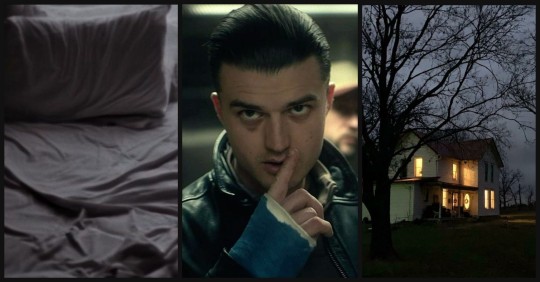
Gator Tillman x fem!reader
A, not so simple, request from the handsome, Sheriff's deputy forces you to confront your burgeoning feelings for him and what an actual relationship with him would entail
"Spend the night with me," Gator breathes, into your neck.
He presses several wet kisses along your skin, as he awaits your response. The feeling of his lips against any part of you is almost enough for you to immediately give in to whatever he wants. Though, in this moment, you hesitate.
"I can't, it's too risky..."
"It'll be fine," he instantly assures, raising his head. "Its late, and everyone will already be asleep. We'll just have to be real quiet though."
"That's all you're worried about?" You then ask, your eyes widening in disbelief.
"Pretty much, yeah," he confidently replies. "This isn't the first time I've snuck a girl into my room."
You decide not to question him further as you begin to pull away with a sigh. His hand is quick to cradle your jaw.
"I just really want to be with ya tonight, is that so bad?" He softly asks, while tilting your head up slightly, to have your eyes meet his.
Even the darkened cab of his truck can't hide the infatuation in his eyes.
"No, it's just-"
He stops you by pressing his thumb to your lips.
"From the way you were moanin' my name a few minutes ago, I would think you'd wanna be with me..."
"Its not that I don't want to be with you, it's just..." you pause, trying to think of a way around revealing the level of repulsion you feel at the thought of being in the same house as his father.
His smug expression fades as you search for the right words.
"Why don't we just go back to mine, like we usually do?" You counter, reaching up to touch his cheek.
"Because I wanna have you in my room tonight," he replies, pulling you closer. "In my bed, where I know you're really mine."
"You shouldn't be so paranoid," you say, dismissively. "I'm not seeing anyone else, Gator, you know that. I only want you."
"Then you should want to spend the night with me," he practically pouts.
It's exasperating how childish he can be sometimes, you think, as instead of rolling your eyes, you kiss his plush bottom lip.
"You're too cute for your own good," you breathe, into another kiss, before pulling away.
"Does that mean-?"
"Yes," you sigh. "You win, now let's go before I change my mind."
You find the stillness of the Tillman house unnerving as you quietly follow Gator through the kitchen. You never had the desire to set foot here, though you knew if you kept dating the Sheriff's son, you would have to cross its threshold eventually. Dread prickles at the back of your neck as you climb the stairs, making you cringe at the slightest creak beneath your feet.
Your frazzled nerves have you squeezing Gator's hand as he leads you towards his room. He smiles as he opens his bedroom door, still silently reveling in his victory.
You're surprised to see his room is illuminated by a soft, purple light. It casts shadows over the posters on his wall, leading you to think it hasn't changed much since he was in high school. Your thoughts are interrupted when he steps in front of you. He wraps his arms around you, pulling you to him. A smile still plays on his lips as he gazes at you.
He takes a few steps back, guiding you further into the room. He then sits on his bed and pulls you onto his lap. Your knees settle into his comforter as you straddle him. His large hands frame your face as he takes a moment to admire you again. He notices your lingering uneasiness before leaning in to kiss you, softly. His tenderness catches you off guard, as you were anticipating the opposite.
"Does being here freak you out that much?" He quietly asks, with his nose pressing into your cheek.
You nod, slightly.
"Just focus on me, then, baby," he breathes before kissing you again. "I'll make ya feel so good, you'll never wanna leave."
You allow yourself to melt into his kiss despite how wrong it feels. Something inside of you urges you to leave, but you're anchored to the man below you. Your lips desperately meet his, over and over, seemingly never wanting to stop.
You quietly sigh his name when his attention switches to your neck. He grins against your skin, loving the way it falls from your lips. He greedily wants more as he presses wet kisses and little bites along your skin. He instantly gets what he wants when he sucks harshly right above your shoulder. Your fingers curl and claw at his shirt as you moan his name a little too loud.
"We gotta be quiet, remember?" He reminds, pressing his finger to your lips.
You nod, your cheeks burning with embarrassment and lust. You kiss the tip of his finger, before whispering an apology.
"Its okay, baby," he soothes, lowering his hand so he can kiss you again. "I know you can't help it... always whinin' and cryin' for me, and I haven't even fucked you yet."
You whimper into another kiss while your nails lightly scrape at the back of his neck.
"That's what you want, right?" He breathlessly adds, between kisses.
"Yes," you reply, nearly delirious with desire.
"Make me yours tonight."
That's all it takes before he's pulling your shirt off. The sensation of his rough hands gliding over your skin makes you shiver.
You're then laying completely bare beneath him as he kneels between your legs. The sight of him is like something out of a dream, or possibly a nightmare, you aren't sure which.
He runs his hands up and down your thighs, making sure your legs stay spread around him. Your eyes linger on how he's throbbing for you, knowing you're aching for him just as much. He places his left hand on your stomach, while his right reaches for your face. His long fingers brush your cheek before he rests his thumb against your lips. He applies only the slightest pressure and you open your mouth just enough so he can drag his thumb across your bottom lip.
"Fuck, look at ya..." he breathes, as his eyes travel your body before meeting yours. "Prettiest fuckin' thing I've ever seen."
You hum in approval, flicking your tongue over the pad of his thumb. He then inhales sharply, pushing it into your mouth. You happily wrap your lips around it and suck, while gazing at him sultrily.
He softly moans before pulling his thumb away, worrying he'd blow his load then and there if you kept on.
"You're too fuckin' good at that, shit..." he pants, while you smile up at him.
"You already know I can't help myself when it comes to you," you defend, as he strokes himself. He smears your saliva over his leaking tip, gasping as he pumps his hand a few times before lining up to ease himself inside you.
Your hands twist into his sheets as his hand covers your mouth. The other on your stomach drifts to your hip, as he pushes himself as deep as he can.
Once his hips meet yours, his gaze darkens as he asks, "Are you gonna be good?"
You nod, your eyes pleading for him to move. With a smirk, he slowly lowers his hand, but keeps a loose grip on your jaw as he begins thrusting his hips in languid strokes. You whine, turning your head to the side, trying to use his pillow to muffle any sounds that might escape.
"No, no, baby," he scolds, using his hold on your jaw to turn your face towards him. "I want ya to keep your eyes on me."
You whine again as you look up, into his eyes. He grins while gently caressing your cheek with his thumb. It's another surprising display of tenderness that he seems to reserve only for you. Your mouth falls open after whispering his name and he immediately places his thumb back, between your lips. You lazily lick against his skin with every thrust as you fight to keep your eyes open.
He curses under his breath, while his hand glides over your stomach, to your breast. He squeezes roughly at first before leaning over to place wet, soothing kisses across your chest. He notices the hickies he left are starting to fade and he's determined to leave new ones. He has to mark you as his, one way or another.
His hair, now a sweaty mess, falls around his face. It tickles your cheeks as he hovers over you. You reach up and brush it out of his eyes, not realizing until then how long it's gotten. He kisses you deeply, while the coarse hair on his chest brushes against you, making you writhe against him.
He breaks the kiss to catch his breath and gaze at you again. You wonder what's going through his head in these quiet moments, but you're too afraid to ask. Afraid that he'll confirm what you already know... that his interest in you goes beyond simple infatuation. You're not sure if you could handle his confession of love, now or at any point.
This wasn't meant to be anything more than a series of casual hookups, but his possessiveness soon changed that. He couldn't stand the thought of another man having you like this. Even the way his own father looked at you infuriated him. For once in his life, he was going to have something that was his and only his.
"Has anyone ever told you how handsome you are?" You softly ask, surprising him and yourself.
He shakes his head. "Just you."
You smile before he kisses you again. He softly moans into your mouth when he feels your legs tightening around his waist. It's your silent way of urging him to keep going.
"Yeah?" He breathily asks. "Ya want more?"
Nodding, you whisper, "Please."
He grins before picking up his pace and roughly thrusting into you. It's all you can do not to scream as you quickly pull him into another kiss. It's sloppy, filled with little whimpers as he fucks you into his mattress.
"This better?" He teasingly asks, with his wet lips at your cheek.
"Y-Yes," you answer, almost too dazed to speak. "Just don't stop, please..."
You hate how whiny your voice sounds but you know it's such a turn on for him.
"I don't plan to. I'm gonna keep ya like this all night," he breathes, into a kiss.
You gasp his name against his plush lips, while your back arches from just how deep he's fucking into you. You're not sure if it's ever felt like this until tonight, so deep and raw.
He needs you to know you truly belong to him. It's something you've known for some time now, but didn't want to admit. It's the dull ache that lingers after he leaves. An ache that increases when you're alone, laying in bed or otherwise. You shouldn't want this, or him, but you're drawn to what's underneath his brash facade. There's a sweetness that's been dormant since childhood, a sweetness that he only feels comfortable revealing to you.
You feel privileged to be the person that gets to experience this side of him. It also frightens you because of how easily you could fall in love with him.
The feeling of his teeth biting into your shoulder jolts you back to reality as you softly cry his name.
"Sorry baby," he breathily apologizes, "ya just feel too good."
"Its okay, just don't bite so hard," you dreamily reply.
He kisses the top of your shoulder, soothing what's going to be one of many marks that litters your skin. Your vision is a purple tinted blur as you struggle to keep the gaze of the man above you.
"I know you're close, I can feel it..." he whispers, as the tip of his nose brushes yours.
Your nails dig into his biceps as he fucks you hard and fast. You're both desperate for release, mouths barely touching, only exchanging low moans and grunts.
You finally connect your lips when your body begins to tremble around him. It's so intense that you can hardly kiss him, as you really just need his lips to absorb all the tiny whines and whimpers of his name.
His bedframe begins to squeak as he thrusts even harder. Your nails claw at his shoulders, through his skin's almost too slippery for you to properly cling to.
"I'm the only one who fucks ya this good, right?" He asks, roughly holding your face.
"Yes, j-just you," you breathe, gasping for the air that's been punched from your lungs.
He flashes a grin before rewarding you with a messy kiss.
"You were made for me and only me," he continues, as he gazes into your watery eyes.
You whine his name one last time and his hips finally still. He presses his forehead to yours as he fills you with everything he has. He's so overwhelmed by the intensity of it, that he doesn't move until his body stops shaking. You're practically being crushed underneath him, but you still too dazed to care.
He's looking at you with renewed adoration, like you're his most cherished possession. Before tonight, this would've frightened you but now it evokes a different emotion. A warm realization settles within you as you think maybe hearing those three little words from him wouldn't be so terrible. For the first time in your life you seriously consider the thought of truly belonging to someone.
A smile spreads across your lips as your hand reaches to cradle his face.
"Will you spend the rest of the night with me?" He softly asks, leaning into your touch. "I don't want to let ya go."
You nod, before guiding his lips to yours.
"And I don't want to go," you whisper into a kiss.
You would worry about the world that lies beyond his bedroom door in the morning. As for the few remaining hours before sunrise, they belonged to you and the man you loved.
#I've missed him so much ��#gator tillman#gator tillman x reader#gator tillman x fem!reader#gator tillman smut
191 notes
·
View notes